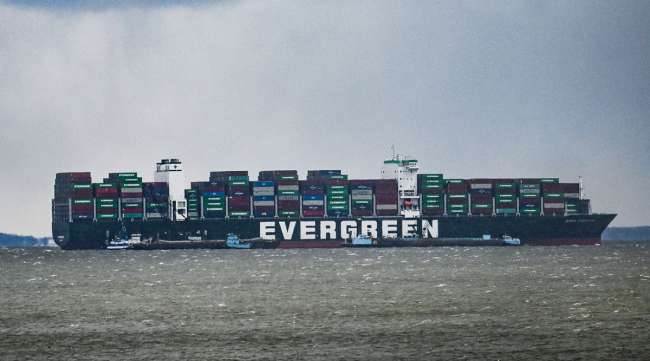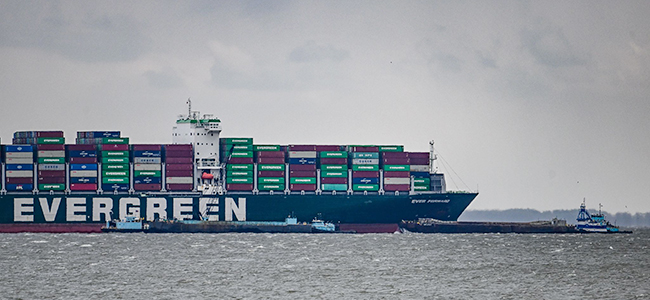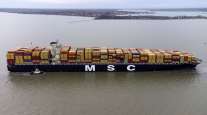Baltimore Sun
Behind the Efforts to Free the Ever Forward

[Stay on top of transportation news: Get TTNews in your inbox.]
The phone at Downs Park, a beach in Pasadena, Md., on the Chesapeake Bay, has rung several times a day for the past two weeks with people asking the same question: “Is the ship still there? Can we come see it?”
The ship, a 1,095-foot cargo carrier called the Ever Forward with more than 4,000 full shipping containers aboard, is still there — just as it has been since March 13, when it missed a turn on its way from Baltimore to Norfolk, Va., exited the 50-foot deep Craighill Channel and barged into shallower waters, lodging itself in more than a dozen feet of mud. That’s where it still sits, stuck.
It is the largest ship to have ever run aground in the Chesapeake Bay, and freeing it is an arduous and cumbersome process. The crew’s 27 members remain on board as two dredges — including the largest clamshell dredge in the Western Hemisphere — work to dig up mud around the hull before authorities lighten the vessel and then, hopefully, pull it out with a fleet of tugboats.
The first attempt to refloat the ship will begin at noon March 29, but it could be a week or more before refloating efforts are successful.
In the meantime, droves of interested onlookers have paid the daily fee of $6 to enter Downs Park, the best place to get a glimpse of the immobile ship.
Compared to last March — a busy one in its own right — there has been an 8% increase in park visitors this month, and park superintendent Nolley Fisher said it could wind up being their busiest March on record as people continue to flock, bemused by the colossal curiosity.
“It’s just a ship sitting there,” Fisher said, “but, hey, people wanna see it. I know people wanna see it move, as well.”
Incredibly Big, Incredibly Stuck
Refloating grounded ships is typically a difficult process, and in the case of the Ever Forward it is especially challenging.
Built in 2020 and sailing under the Hong Kong flag, the Ever Forward was traveling from the Port of Baltimore to Norfolk on the evening of March 13, when, at a speed of 13 knots, it did not turn south with the Craighill Channel and instead plowed into a shallow area outside the channel. The ship, which requires a depth of at least 42 feet to safely navigate, entered water that is only 24 feet deep, submerging itself in up to 18 feet of mud.
“She is sitting, resting on the bottom,” U.S. Coast Guard Captain David O’Connell, the sector commander, said last week, “and basically when she came to rest, she tunneled into the mud and silt, so she’s about 15 feet or so into the mud.”
The reason for the grounding is unknown — and it likely will be for a long while — but O’Connell named four categories of potential causes: mechanical failure, operational failure, environmental factors (like weather) or human error.
Dredging, Lightening and Tugging
Containerships as massive as the Ever Forward are relatively new to Baltimore and the upper reaches on the bay. Long common in the Pacific trade, such ships started making their way from Asia to the U.S. East Coast after the Panama Canal was expanded in 2016.
“We are seeing a trend towards these larger and larger ships,” said Pete Lesher, curator at the Chesapeake Bay Maritime Museum.
Throw in supply chain problems that have backed up West Coast ports, and massive ships have begun calling more often at ports like Baltimore.
Ever Forward is owned by the same Taiwanese company, Evergreen Marine Corp., as the Ever Given — the even-larger ship that became wedged in the Suez Canal a year ago, choking off a busy, vital passage for global trade, disrupting the international supply chain and grabbing headlines.
That ship was freed in six days, but the Ever Forward has been stuck for two weeks and counting for a few reasons: The Ever Forward is more completely lodged into mud, there is less urgency since it isn’t blocking the channel, and there are fewer salvage resources available than in the Suez.

A dredge barge is moved into place to take on more sediment as dredges work to free the grounded Ever Forward containership. (Jerry Jackson/Baltimore Sun via Tribune News Agency)
Donjon Smit, the ship’s salvor, has developed a plan that was approved by Maryland’s Board of Public Works as an emergency license, and it is working alongside the Coast Guard and the Maryland Department of the Environment on rescue efforts. The plan, obtained through a Maryland Public Information Act request, permits the salvor to mechanically dredge an area of 349,427 square feet “to a depth of 40 feet at mean low water.” The muck — more than 110,000 cubic yards of it, which can fill about 33 Olympic-sized swimming pools — will then be deposited at Poplar Island, a restored wildlife habitat built with dredged material about 20 miles south of the ship.
More than a dozen vessels have assisted in the dredging process, which involves scooping out mud from the bay bottom around the Ever Forward. One of two dredges on scene, the Dale Pyatt, is the largest clamshell dredge in the western hemisphere and can scoop 60 cubic yards in its bucket.
Despite its superlative size, though, the Dale Pyatt isn’t as efficient as the dredges that helped free the Ever Given in the Suez Canal. Those were suction dredges, which can break up rock and act almost like underwater vacuums, sucking up muck more quickly than a clamshell dredge, which acts more like a shovel.
“They are thimbles compared to … what a suction dredge can do,” said Sal Mercogliano, a professor of maritime history at Campbell University in North Carolina.
Dredging has continued — bucket by big bucket — for more than a week, and the hope is to, beginning at noon March 29, pull the ship back into the 50-foot deep waters of the channel.
William Doyle, the Port of Baltimore’s executive director, said March 27 that the first refloating attempt will use five tugboats.
Should that attempt be unsuccessful, authorities will dredge more, lighten the ship by removing ballast and fuel, and try to pull it out again on April 3 or 4.
Refloating efforts may try to capitalize on the daily high tide, which offers a few more inches of water depth. Mercogliano even suggested waiting a couple of weeks, when a full moon will lead to a higher tide.
“Their best chance is with the spring tide in mid-April, about on April 18,” he said.
Potential for Impact on Shipping
Tracy Alloway wanted to boil chicken and vegetables March 24 in her and her husband’s new apartment in New York City but ran into a problem. Her pots and pans, along with almost all of her belongings, are stuck on the Ever Forward.
Alloway, a Bloomberg reporter, moved from Hong Kong to New York in early February. Save for a few pieces of luggage they flew with, she and her husband packed their entire apartment, including furniture and the bulk of their clothes, and shipped it to the U.S. It should have arrived by now, but instead it’s sitting in the bay off Anne Arundel County while they sit on chairs they’ve purchased to temporarily furnish their sparse Manhattan apartment.
“It would be very nice, at this point, to be able to sit on a couch and watch TV,” she said.
But outside of those who, like Alloway, have belongings on the Ever Forward, the ship has had little impact on the global supply chain. Unlike the Ever Given blocking the Suez Canal, the Ever Forward has not stopped shipping traffic.
There is now only one-way traffic for larger ships near the Ever Forward, but otherwise, impact on shipping has been minimal.
The channel will, however, be closed for several hours March 29 during the refloating attempt, and if that try is unsuccessful, many of the ship’s truck-sized containers may need to be removed.
“That’s kind of the last thing we want to do,” O’Connell said.
Container removal would necessitate a massive crane on a separate boat next to the Ever Forward, methodically picking up each container and placing it on a barge or other ship. For that to be done safely, O’Connell said they would close the channel to traffic to prevent wakes from passing ships.
“The goal is to avoid, to minimize any impacts to the marine transportation system as much as possible,” O’Connell said. “We’re trying to avoid container removal. Still planning for it, but hoping that that won’t be the case.”
The longer the salvage effort takes, the more complicated the process can become. There is the potential for fuel leakage (which authorities are monitoring) as the ship’s hull sits in mud, rather than floats in water as designed. And should dredging last past April 1, the Board of Public Works recommended that the salvage crew maintain a turbidity curtain — an impermeable barrier in the water — surrounding the work area.
Want more news? Listen to today's daily briefing above or go here for more info
That curtain is recommended from April 1 to June 1 due to migrating fish and from June 1 to Sept. 30 due to potential impacts to a nearby natural oyster bar.
Of course, authorities don’t expect the project to last into the summer, but Mercogliano said last week that their plan may be “overly optimistic.”
If it does remain stuck for weeks, it could make an impact on shipping traffic — and it could mean that Alloway, who only packed winter clothes when she flew back to the U.S. in February, will be without her wardrobe for an extended period of time.
“I might have to go to the mall for a bit,” she said.
Distributed by Tribune Content Agency, LLC



